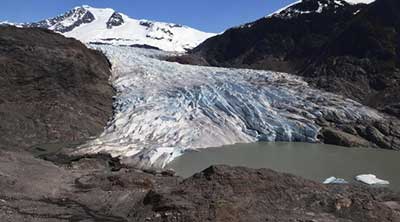Date: 22/04/2023
Relevance: GS-3: Conservation, environmental pollution and degradation, environmental impact assessment.
Key Phrases: Glaciers, Antarctic Sea, World Meteorological Organization, Greenhouse Gases, 2015 Paris Agreement, La Nina, Saharan Dust, Greenland Glaciers, Biosphere.
Context:
- The UN's World Meteorological Organization (WMO) released its annual climate overview report recently, revealing alarming climate change indicators.
Key Highlights
- The report states that the world's glaciers melted at an unprecedented rate in 2022, making their salvation effectively impossible.
- Furthermore, greenhouse gas concentrations reached new global highs in 2021, and the concentration of carbon dioxide (CO2) rose to 415.7 parts per million globally, or 149% of the pre-industrial (1750) level.
- The WMO's report indicates that the world's reference glaciers, for which long-term observations exist, saw an average thickness loss of more than 1.3 meters between October 2021 and October 2022, a loss much larger than the average over the last decade.
- In Europe, the Alps smashed records for glacier melt due to a combination of little winter snow, an intrusion of Saharan dust in March 2022, and heatwaves between May and early September.
Record High Temperatures and Greenhouse Gas Concentrations:
- The WMO report states that the last eight years have been the warmest ever recorded. Meanwhile, concentrations of greenhouse gases such as carbon dioxide, methane, and nitrous oxide reached new peaks.
- The concentration of carbon dioxide reached 415.7 parts per million globally, or 149% of the pre-industrial (1750) level, while methane reached 262% and nitrous oxide hit 124%.
- The report also notes that the world's oceans experienced record high temperatures, where around 90% of the heat trapped on Earth by greenhouse gases ends up.
Sea Levels at a Record High
- The Sea levels are also at a record high, having risen by an average of 4.62 millimeters per year between 2013 and 2022, double the rate it was between 1993 and 2002.
- This rise in sea levels is due to the melting of glaciers and ice sheets, as well as thermal expansion caused by warming oceans.
The Paris Agreement
- The 2015 Paris Agreement saw countries agree to cap global
warming at "well below" two degrees Celsius above average levels measured
between 1850 and 1900, and 1.5 degrees Celsius if possible.
- However, the global mean temperature in 2022 was 1.15 C above the 1850-1900 average, the WMO report said.
- The report also states that the cooling impact of a drawn-out La Nina weather phenomenon that stretched over nearly half of the past eight years had little impact on the high global mean temperatures.
Glacier Melting: A Lost Caus
- The WMO report is clear that saving the world's glaciers is effectively a lost cause. The WMO chief stated in an interview that "we have already lost the melting of the glaciers game because we already have such a high concentration of CO2."
- The melting of the glaciers will limit freshwater supplies for
humans and agriculture and harm transport links if rivers become less
navigable.
- "These kinds of things are going to be a big risk for the future," said the WMO chief.
- "Many of these mountain glaciers will disappear, and also the shrinking of the Antarctic and Greenland glaciers will continue for a long-term basis, unless we create a means to remove CO2 from the atmosphere."
Optimism and Mitigation
- Although the report highlighted some alarming findings, the Chief of the World Meteorological Organization (WMO) expressed optimism about the fight against climate change.
- He noted that the cost of green energy is becoming more
affordable than fossil fuels, and better mitigation methods are being
developed.
- Additionally, he highlighted that 32 countries have successfully reduced their emissions while continuing to grow their economies, indicating that economic growth and emissions growth are no longer automatically linked.
- These positive developments provide hope that with continued efforts, we can mitigate the impacts of climate change and build a sustainable future.
Conclusion
- The latest report from the United Nations highlights the alarming
state of the world's climate and the impact of human activity on the
environment.
- The accelerated melting of the world's glaciers is a cause for concern as it poses a threat to the planet's freshwater supply, agriculture, and transportation.
- The report also shows that greenhouse gas concentrations have reached new global highs, resulting in record high temperatures and sea levels.
- However, there is a glimmer of hope as countries have shown a
willingness to reduce emissions and develop mitigation methods.
- It is essential to prioritize collective action to tackle climate change and reduce greenhouse gas emissions to ensure a sustainable future for all.
Source: The Hindu
Mains Question:
Q. In the last decade, how has the global approach to climate change transformed, and what are the chances of achieving the Paris Agreement's objective of capping global warming at 1.5 C above pre-industrial levels? What measures must be taken to achieve this? (250 words).






















